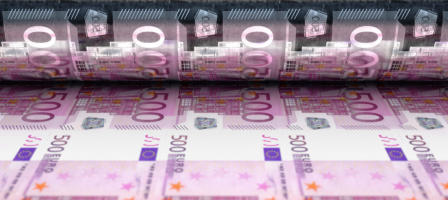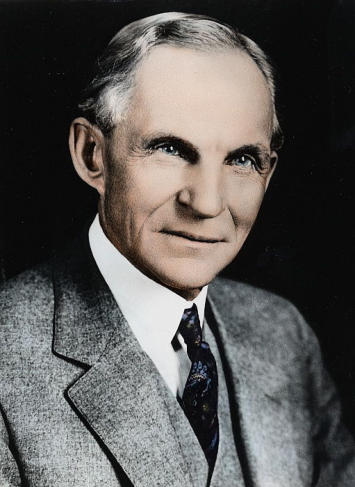

Money creation
Do you know how money is created?
Anyone who still believes that banks only lend money that they actually own is completely wrong.
The
majority
of
people
are
under
the
misconception
that
the
money
banks
lend
to
borrowers
comes
from
customer
deposits
and
that
if
someone
is
unable
to
repay
their
loan,
the
bank
suffers
a
loss
as
a
result.
This
is
far
from
the
case!
I
would
therefore
like
to
explain
the
process of so-called "bank money creation" using this example:
A
customer,
let's
call
him
Anton,
deposits
100
euros
in
cash
into
his
current
account
at
his
bank.
In
return,
he
receives
100
euros
credited
to his account. The bank calls this balance a "sight deposit".
Anton can now access these 100 euros at any time, either by making a cashless transfer or by withdrawing cash.
As
the
bank
is
clever,
it
doesn't
just
leave
this
deposited
100
euros
lying
around
and
wait
for
Anton
to
withdraw
some
of
it
at
some
point,
but "works" with it.
If
Anton
now
wants
to
make
a
transfer
to
another
customer
of
the
same
bank,
let's
call
him
Bert,
the
bank
doesn't
even
have
to
touch
these
100
euros.
It
only
has
to
deduct
this
amount
from
Anton's
account
in
the
computer
and
add
it
to
Bert's
account.
Over
the
years,
the
bank
has
gained
a
certain
amount
of
experience
as
to
what
percentage
of
its
sight
deposits
is
required
as
a
cash
reserve
in
order
to
be
able
to
cope
with
the
ongoing
withdrawals
and
transfers
to
other
banks.
The
banks
call
this
the
"technical
minimum
reserve".
In
order
to
be "allowed" to "work" with the money, the bank must also deposit the legally prescribed minimum reserve with the central bank.
All in all, this means that the bank has to hold around 3% of its sight deposits in reserve.
It can therefore "work" with the remaining 97%.
Of
the
100
euros
that
Anton
has
paid
in,
she
will
therefore
only
keep
3
euros
as
a
reserve,
the
other
97
euros
are
labelled
by
the
bank
as
"surplus reserve".
Incidentally,
it
is
not
even
legally
clear
to
whom
this
so-called
surplus
reserve
belongs.
And
since
this
is
not
clearly
clarified
by
law,
the
bank considers it legitimate to dispose of this "surplus reserve" completely freely, of course without informing Anton.
The bank may now grant this 97 euros to a borrower as a loan, or it may act as if this 97 euros were the minimum reserve for a new loan.
In
this
way,
she
now
grants
another
customer,
let's
call
him
Christian,
a
loan
totalling
3233.33
euros.
This
means
that
the
3%
reserve,
which she needs, is exactly the 97 euros "surplus reserve" from Anton's paid-in 100 euros.
The bank's balance sheet now shows a liability of 3233.33 euros to Christian, who now wants to dispose of this money.
At
the
same
time,
however,
the
bank
now
has
a
receivable
of
EUR
3233.33
from
Christian,
as
he
has
to
repay
the
amount
with
compound
interest.
On
the
assets
side,
as
well
as
on
the
liabilities
side,
the
bank's
balance
sheet
therefore
shows
an
amount
of
3233.33
euros,
which
can
be
described as a transaction not recognised in profit or loss.
However,
the
bank
will
earn
interest
on
these
3233.33
euros
and,
in
the
event
that
Christian
is
unable
to
repay
his
loan,
the
bank
will
legally
take
away
Christian's
property,
which
he
has
deposited
as
collateral
for
the
loan.
This
is
despite
the
fact
that
the
bank
has
not
suffered any loss, because the money for the loan was not even in the bank's possession.
So
what
happened?
The
bank
received
100
euros
in
cash
from
Anton
and
then
granted
3233.33
euros
as
a
loan
to
Christian,
purely
through
accounting
transactions.
In
this
way,
3133.33
euros
were
"created"
or
rather
"scooped
up"
that
were
not
there
before.
And
although this is not cash, this so-called "bank money" is just as usable in real terms.
A
few
transactions
by
the
bank
have
now
created
money
that
Christian
has
to
pay
back
with
interest
without
the
bank
having
provided
anything in return.
By the way, Henry Ford once said:

If people understood
the monetary system,
we would have a revolution,
before tomorrow morning!

Money creation
Do you know how money is
created?
Anyone
who
still
believes
that
banks
only
lend
money
that
they
actually
own
is
completely wrong.
The
majority
of
people
are
under
the
misconception
that
the
money
banks
lend
to
borrowers
comes
from
customer
deposits
and
that
if
someone
is
unable
to
repay
their
loan,
the
bank
suffers
a
loss
as
a
result.
This
is
far
from
the
case!
I
would
therefore
like
to
explain
the
process
of
so-called
"bank
money
creation"
using
this
example:
A
customer,
let's
call
him
Anton,
deposits
100
euros
in
cash
into
his
current
account
at
his
bank.
In
return,
he
receives
100
euros
credited
to
his
account.
The
bank
calls
this
balance
a
"sight
deposit".
Anton
can
now
access
these
100
euros
at
any
time,
either
by
making
a
cashless
transfer
or
by
withdrawing cash.
As
the
bank
is
clever,
it
doesn't
just
leave
this
deposited
100
euros
lying
around
and
wait
for
Anton
to
withdraw
some
of
it
at
some
point,
but
"works" with it.
If
Anton
now
wants
to
make
a
transfer
to
another
customer
of
the
same
bank,
let's
call
him
Bert,
the
bank
doesn't
even
have
to
touch
these
100
euros.
It
only
has
to
deduct
this
amount
from
Anton's
account
in
the
computer
and
add
it
to
Bert's
account.
Over
the
years,
the
bank
has
gained
a
certain
amount
of
experience
as
to
what
percentage
of
its
sight
deposits
is
required
as
a
cash
reserve
in
order
to
be
able
to
cope
with
the
ongoing
withdrawals
and
transfers
to
other
banks.
The
banks
call
this
the
"technical
minimum
reserve".
In
order
to
be
"allowed"
to
"work"
with
the
money,
the
bank
must
also
deposit
the
legally
prescribed
minimum
reserve
with the central bank.
All
in
all,
this
means
that
the
bank
has
to
hold
around 3% of its sight deposits in reserve.
It can therefore "work" with the remaining 97%.
Of
the
100
euros
that
Anton
has
paid
in,
she
will
therefore
only
keep
3
euros
as
a
reserve,
the
other
97
euros
are
labelled
by
the
bank
as
"surplus reserve".
Incidentally,
it
is
not
even
legally
clear
to
whom
this
so-called
surplus
reserve
belongs.
And
since
this
is
not
clearly
clarified
by
law,
the
bank
considers
it
legitimate
to
dispose
of
this
"surplus
reserve"
completely
freely,
of
course
without
informing Anton.
The
bank
may
now
grant
this
97
euros
to
a
borrower
as
a
loan,
or
it
may
act
as
if
this
97
euros were the minimum reserve for a new loan.
In
this
way,
she
now
grants
another
customer,
let's
call
him
Christian,
a
loan
totalling
3233.33
euros.
This
means
that
the
3%
reserve,
which
she
needs,
is
exactly
the
97
euros
"surplus
reserve"
from Anton's paid-in 100 euros.
The
bank's
balance
sheet
now
shows
a
liability
of
3233.33
euros
to
Christian,
who
now
wants
to
dispose of this money.
At
the
same
time,
however,
the
bank
now
has
a
receivable
of
EUR
3233.33
from
Christian,
as
he
has to repay the amount with compound interest.
On
the
assets
side,
as
well
as
on
the
liabilities
side,
the
bank's
balance
sheet
therefore
shows
an
amount
of
3233.33
euros,
which
can
be
described
as a transaction not recognised in profit or loss.
However,
the
bank
will
earn
interest
on
these
3233.33
euros
and,
in
the
event
that
Christian
is
unable
to
repay
his
loan,
the
bank
will
legally
take
away
Christian's
property,
which
he
has
deposited
as
collateral
for
the
loan.
This
is
despite
the
fact
that
the
bank
has
not
suffered
any
loss,
because
the
money
for
the
loan
was
not
even in the bank's possession.
So
what
happened?
The
bank
received
100
euros
in
cash
from
Anton
and
then
granted
3233.33
euros
as
a
loan
to
Christian,
purely
through
accounting
transactions.
In
this
way,
3133.33
euros
were
"created"
or
rather
"scooped
up"
that
were
not
there
before.
And
although
this
is
not
cash,
this
so-called
"bank
money"
is
just
as
usable
in real terms.
A
few
transactions
by
the
bank
have
now
created
money
that
Christian
has
to
pay
back
with
interest
without
the
bank
having
provided
anything in return.
By the way, Henry Ford once said:

If people understood
the monetary system, we
would have a revolution,
before tomorrow morning!



















